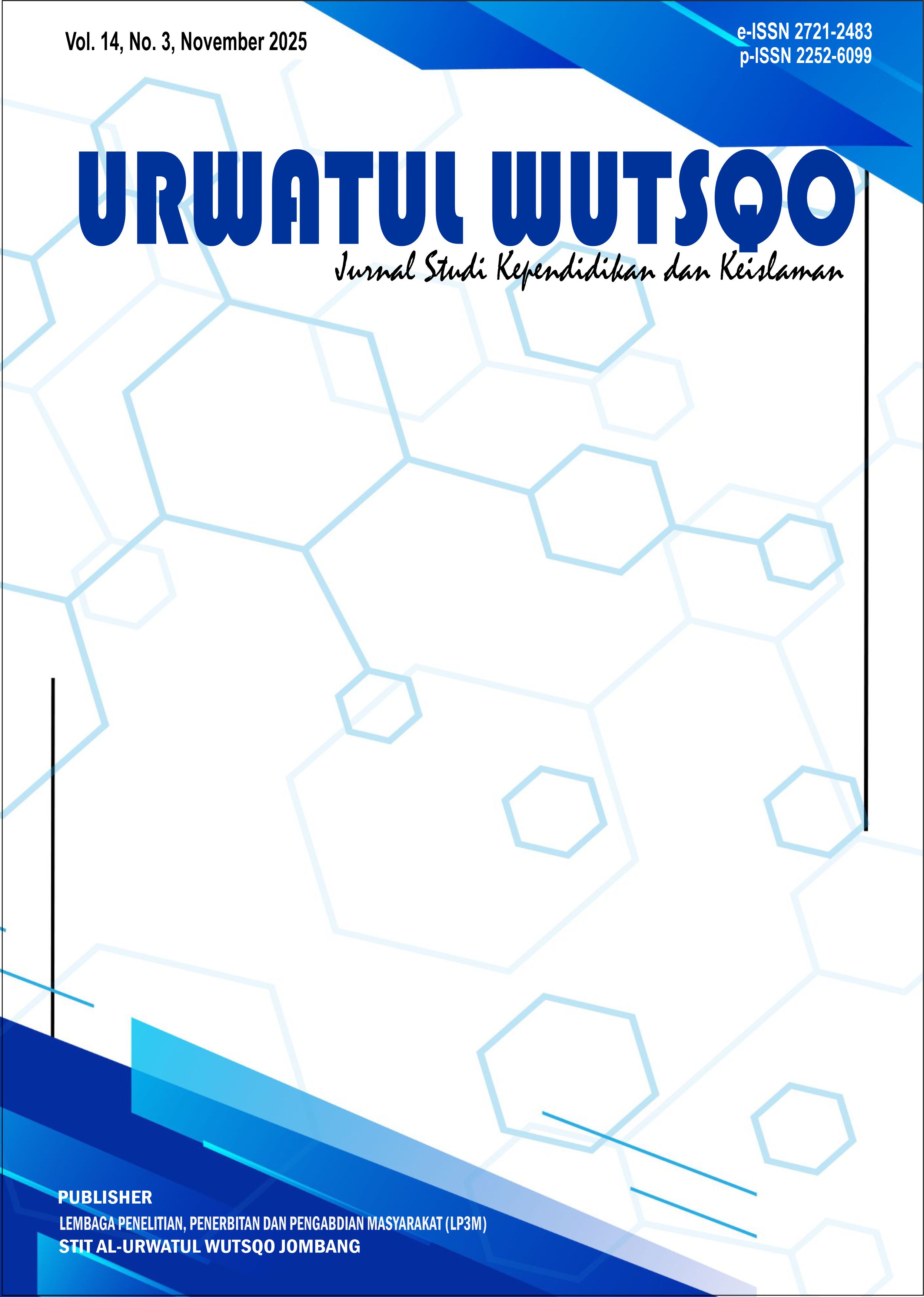Prophetic Ethics In Hadith Tolerance As The Moral Foundation Of Muslims In Digital Interactions
DOI:
https://doi.org/10.54437/urwatulwutsqo.v14i3.2538Keywords:
Prophetic ethics, Hadith tolerance, digital civility, Islamic communication ethicsAbstract
This study explores Prophetic Ethics in Hadith Tolerance as the moral foundation for Muslims’ digital interactions, highlighting the relevance of prophetic moral values in shaping ethical online behavior. In an era characterized by rapid communication and moral fragmentation, the Prophet Muhammad’s teachings, embodied in the hadiths of rahmah (compassion), tasamuh (tolerance), hikmah (wisdom), and musyawarah (deliberation), offer a timeless ethical framework for guiding digital civility. Using a qualitative-descriptive approach through library-based content analysis, this research examines canonical hadith compilations (Sahih al-Bukhari, Sahih Muslim, Sunan Abu Dawud, Jami’ al-Tirmidhi, and Musnad Ahmad) and relevant classical commentaries to derive thematic moral categories and contextualize them within the ethics of digital communication. The findings reveal that the Prophet’s ethical model integrates emotional, intellectual, and social dimensions of morality: rahmah promotes digital empathy, tasamuh nurtures respect for diversity, hikmah cultivates reflective and responsible communication, and musyawarah encourages collaborative dialogue and consensus-building in digital spaces. Together, these principles form the “Prophetic Digital Ethics Framework,” an integrative moral paradigm that transforms online engagement into an arena of mercy, respect, and justice. This study contributes theoretically to Islamic moral scholarship by recontextualizing hadith ethics in digital life and practically by offering ethical guidance for fostering digital civility among Muslims in the contemporary era.
Downloads
References
Abu Dawud. (n.d.). Sunan Abi Dawud, Kitab al-Adab.
Ahmad bin Hanbal. (n.d.). Musnad Ahmad (Hadith No. 22802).
Al-Bukhari. (n.d.). Sahih al-Bukhari (Hadith No. 6011).
Al-Bukhari. (n.d.). Sahih al-Bukhari (Hadith No. 6018).
Alghamdi, M. (2018). Digital ethics in Islam: Revisiting akhlaq in the age of information. Journal of Islamic Civilization and Culture, 6(1), 15–28.
Alzaidi, M. (2025). Persuasion strategies in the prophetic hadith of tolerance. Cogent Arts & Humanities, 12(1), 2505937. https://doi.org/10.1080/23311983.2025.2505937
Bowen, G. A. (2009). Document analysis as a qualitative research method. Qualitative Research Journal, 9(2), 27–40. https://doi.org/10.3316/QRJ0902027
Elo, S., Kääriäinen, M., Kanste, O., Pölkki, T., Utriainen, K., & Kyngäs, H. (2014). Qualitative content analysis: A focus on trustworthiness. SAGE Open, 4(1), 1–10. https://doi.org/10.1177/2158244014522633
Flick, U. (2018). An introduction to qualitative research (6th ed.). SAGE Publications.
Hassan, A., & Ahmad, F. (2022). Islamic ethics and digital citizenship: Toward a framework for Muslim online behavior. Journal of Media Ethics, 37(4), 231–247. https://doi.org/10.1080/08900523.2022.2047719
Kilic, M. A., Ghazali, M. A., & Shehab, J. M. (2025). Prophetic ethics in Islamic thought: A contemporary analytical study of the Qur’anic message and philosophical morality. Journal of Islamic Ethics, 15(3), 221–239.
Krippendorff, K. (2018). Content analysis: An introduction to its methodology (4th ed.). SAGE Publications.
Mazya, A., Al-Munawar, M. S., & Ridwan, M. (2024). Cultural and religious diversity as a source of conflict: The challenge of building religious moderation in Indonesia. International Journal of Islamic Civilization Studies, 14(1), 55–73.
Mostfa, M. (2021). Islam and terrorism: The distortion of jihad and the global perception of Islam. Journal of Islamic World Studies, 8(2), 89–107.
Muslim. (n.d.). Sahih Muslim (Hadith No. 2564).
Nowell, L. S., Norris, J. M., White, D. E., & Moules, N. J. (2017). Thematic analysis: Striving to meet the trustworthiness criteria. International Journal of Qualitative Methods, 16(1), 1–13. https://doi.org/10.1177/1609406917733847
Parray, T. A. (2021). Prophetic model of ethics and interreligious coexistence: Contemporary relevance. Religions, 12(11), 962. https://doi.org/10.3390/rel12110962
Ramadhan, A., Nur, M., & Hidayah, R. (2024). Prophetic ethics in modern education: Integrating rahmah, tasamuh, hikmah, and musyawarah. Journal of Islamic Studies and Ethics, 18(2), 88–106.
Schreier, M. (2012). Qualitative content analysis in practice. SAGE Publications.
Shodiqoh, R. (2024). Social media ethics in a contemporary Islamic perspective. Sicopus Journal of Communication and Islamic Studies, 7(2), 144–158. https://journal.walideminstitute.com/index.php/sicopus/article/download/153/414
Supriatna, H., Kuswana, D., & Saprudin, A. (2025). The role of social media in fostering religious tolerance. Journal of Social and Islamic Affairs, 10(1), 45–62.* https://journal.ar-raniry.ac.id/index.php/jsai/article/download/5754/2965
Tirmidhi. (n.d.). Sunan al-Tirmidhi (Hadith No. 1924).
Umanah, R., Abdullah, A., & Zakaria, H. (2024). The digital era of hadith: Challenges of authenticity and opportunities for innovation. International Journal of Islamic Studies, 12(4), 201–216. https://www.researchgate.net/publication/388855109
Yahya, M. (2023). Ethical challenges in digital da’wah: Between virtue and viral culture. Journal of Contemporary Islamic Communication, 5(2), 67–82.
Downloads
Published
How to Cite
Issue
Section
License
Copyright (c) 2025 Muhammad Farizal Amri

This work is licensed under a Creative Commons Attribution-ShareAlike 4.0 International License.









